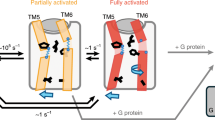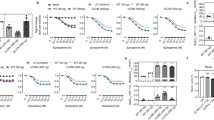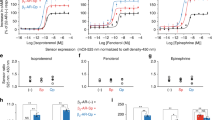Abstract
Eukaryotic cells have evolved a variety of mechanisms for dampening their responsiveness to hormonal stimulation in the face of sustained activation. The mechanisms for such processes, collectively referred to as desensitization, often involve alterations in the properties and number of cell-surface hormone receptors1–3. It has been speculated that phosphorylation–dephosphorylation reactions, which are known to regulate the catalytic activities of enzymes, also regulate the function of receptors4. Highly specific receptor kinases, such as rhodopsin kinase5 and β-adrenergic receptor kinase6, which show stimulus-dependent phosphorylation of receptors have been described. Direct evidence for a causal relationship between receptor phosphorylation and desensitization has been lacking however. Here we report that prevention of agonist-stimulated β2-adrenergic receptor (β2AR) phosphorylation by truncation of its serine and threonine-rich phosphate acceptor segment delays the onset of desensitization. We also show that selective replacement of these serine and theronine residues by alanine and glycine delays desensitization even further. These data provide the first direct evidence that one molecular mechanism of desensitization of G-protein-coupled receptors involves their agonist-induced phosphorylation.
This is a preview of subscription content, access via your institution
Access options
Subscribe to this journal
Receive 51 print issues and online access
$199.00 per year
only $3.90 per issue
Buy this article
- Purchase on Springer Link
- Instant access to full article PDF
Prices may be subject to local taxes which are calculated during checkout
Similar content being viewed by others
References
Harden, T. K. Pharmac. Rev. 35, 5–23 (1983).
Clark, R. B. Adv. Cyclic Nucleotide Res. 20, 155–209 (1986).
Sibley, D. R. & Lefkowitz, R. J. Nature 317, 124–129 (1985).
Sibley, D. R., Benovic, J. L., Caron, M. G. & Lefkowitz, R. J. Cell 48, 913–922 (1987).
Kuhn, H. & Dreyer, W. J. FFBS Lett. 20, 1–6 (1972).
Benovic, J. L., Strasser, R. H., Caron, M. G. & Lefkowitz, R. J. Proc. natn. Acad. Sci. U.S.A. 83, 2797–2801 (1986).
Dixon, R. A. F. et al. Nature 321, 75–79 (1986).
Dohlman, H. G., Bouvier, M., Benovic, J. L., Caron, M. G. & Lefkowitz, R. J. J. biol. Chem. 262, 14282–14288 (1987).
Henderson, R. & Umwin, P. N. T. Nature 257, 28–32 (1975).
Hargrave, P. A. et al. Neurochem. Int. 1, 231–244 (1980).
Thompson, P. & Findlay, J. B. C. Biochem. J. 220, 773–780 (1984).
Miller, J. L. & Dratz, E. A. Vision Res. 24, 1509–1521 (1984).
Bouvier, M. et al. Molec. Pharmac. 33, 133–139 (1988).
Homburger, V. et al. J. biol. Chem. 255, 10436–10444 (1980).
Waldo, G. L., Northup, A. J. K., Perkins, J. P. & Harden, T. K. J. biol. Chem. 258, 13900–13908 (1983).
Strader, C. D. et al. Cell 49, 855–863 (1987).
Benovic, J. L. et al. Proc. natn. Acad. Sci. U.S.A. 24, 8879–8882 (1987).
Huganir, R. L., Delcour, A. H., Greengard, P. & Hess, G. P. Nature 321, 774–776 (1986).
Kobilka, B. K. et al. J. biol. Chem. 262, 7321–7327 (1987).
Cullen, B. Meth. Enzym. 152, 684 (1987).
Gorman, C. in DNA cloning, A Practical Approach Vol. II. (ed. Glover, D. M.) 143–290 (IRL Press, Oxford, 1985).
Laemmli, U. K. Nature 227, 680–686 (1970).
Shorr, R. G. L., Lefkowitz, R. J. & Caron, M. G. J. biol. Chem. 256, 5820–5826 (1981).
Salomon, Y., Londos, C. & Rodbell, M. Analyt. Biochem. 58, 541–548 (1974).
DeBlasi, A., Lipartiti, M., Motulsky, S., Insel, P. A. & Fratelli, M. J. clin. Endocr. Metab. 61, 1081–1088 (1985).
Author information
Authors and Affiliations
Rights and permissions
About this article
Cite this article
Bouvier, M., Hausdorff, W., Blasi, A. et al. Removal of phosphorylation sites from the β2-adrenergic receptor delays onset of agonist-promoted desensitization. Nature 333, 370–373 (1988). https://doi.org/10.1038/333370a0
Received:
Accepted:
Issue Date:
DOI: https://doi.org/10.1038/333370a0
This article is cited by
-
The multifaceted functions of β-arrestins and their therapeutic potential in neurodegenerative diseases
Experimental & Molecular Medicine (2024)
-
Molecular mechanism of GPCR-mediated arrestin activation
Nature (2018)
-
Catalytic activation of β-arrestin by GPCRs
Nature (2018)
-
Multiple functions of G protein-coupled receptor kinases
Journal of Molecular Signaling (2014)
-
Roles of the α1A-adrenergic receptor carboxyl tail in protein kinase C-induced phosphorylation and desensitization
Naunyn-Schmiedeberg's Archives of Pharmacology (2010)
Comments
By submitting a comment you agree to abide by our Terms and Community Guidelines. If you find something abusive or that does not comply with our terms or guidelines please flag it as inappropriate.



